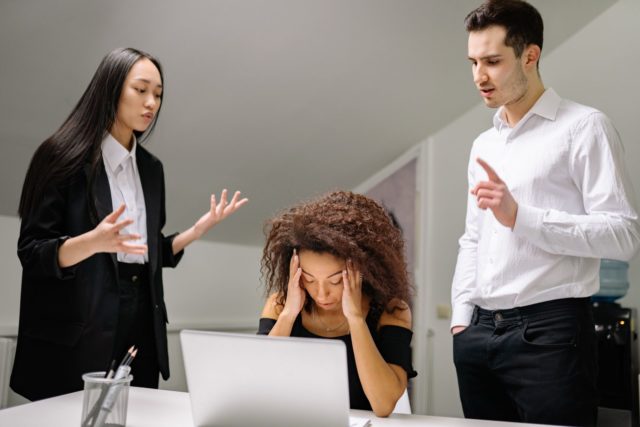For HR teams and operations managers, one of the most important parts of the job is resolving interdepartmental conflict and preventing it before it starts.
But as a company scales, the number of relationships between people increases exponentially. A company of just 10 people has 45 different relationships in it, and each one of them is a place where conflict can arise. A company of 25 has 300.
Conflicts can slow down time-sensitive projects and lead to increased employee turnover. In this article, we’ll cover what causes interdepartmental conflict and what you can do to resolve it.

Common causes of interdepartmental conflicts
Interdepartmental conflicts are more common in large-scale businesses, taking up valuable time and effort and leading projects off-track. These conflicts are causes by issues such as communication breakdowns, goal misalignment, and role ambiguity.
Communication breakdowns
Interdepartmental conflicts often arise due to breakdowns in communication.
Misunderstandings can stem from poorly defined job roles or vague project goals. In a busy organization, information can be lost or misinterpreted as it moves across departments. This can lead to confusion and misaligned expectations. If those different expectations cause problems, they can cause disputes.
A lack of transparency from management can also fuel conflict. If a department isn’t included in discussions that affect their work, the team will feel blindsided. Every team has competing priorities, and if managers can’t come to a compromise ahead of time, then conflict is inevitable.
Goal misalignment
Misalignment of goals is another key contributor to interdepartmental conflicts. When departments have conflicting objectives, it can lead to tensions as they compete for resources.
If one department is focused on cost reduction and another is driven by quality, there’s an inherent conflict. Teams might be able to discuss and compromise this, but if they have conflicting objectives and key results (OKR), it’s a more serious conflict.
It’s easy to get into these situations if there’s no clear strategy or vision for the company. That’s why it’s important for executives and managers to make sure the OKRs are all aligned with each other.
Power struggles and role ambiguity
In a small company, people expect to be wearing many hats. The designer might be the de-facto marketing manager until the company can afford to hire a specialist.
That said, in a large organization, people need narrowly defined job descriptions to work efficiently. When teams develop their own ways of doing things, they can get annoyed about other teams stepping on their toes and doing things another way.
On top of this, if two teams’ duties are overlapping, they can end up conflicting over who gets to make decisions about that part of the business which can ultimately begin to erode your company’s work environment.
How to resolve interdepartmental conflicts
Resolving interdepartmental conflicts requires a proactive approach. This includes building a conflict resolution framework that sets out clear procedures for addressing disputes. Managers also have to think about communications strategies, aligning goals and objectives, and allocating resources where they’re needed.

Build a conflict-resolution framework
Creating a clear conflict-resolution framework and getting conflict-resolution training is a great first step to handling conflicts as they happen. Steps might include:
- Initial identification and acknowledgment of the conflict.
- A thorough investigation to understand its root causes.
- A collaborative problem-solving approach to find a solution that all parties can agree on.
While you’ll want to adapt your framework to what is and is not working for you, there are some commonly used frameworks you can use as a template to start with.
- Thomas–Kilmann Conflict Mode Instrument: This model presents five strategies, these being Competing, Avoiding, Accommodating, Collaborating, and Compromising. Managers will choose the right strategy based on how much assertiveness and cooperation the situation requires.
- Interest-Based Relational Approach: This looks to protect relationships by managing conflict in a way that focuses on mutual interests. It highlights the importance of open communication, non-threatening behavior, and empathy.
- Circle of Conflict Model: This model categorizes conflicts into five types. These are Data conflicts, Interest conflicts, Relationship conflicts, Structural conflicts, and Value conflicts. Each has different strategies for resolution.
- Conflict Resolution Process Model: This model’s five steps include identifying the problem, looking for solutions, choosing a solution, implementing the solution, and reviewing the solution.
It’s also useful to know that there are conflict resolution services available, such as those offered by Pollack Peacebuilding Systems, to make the training process run smoothly and guarantee that everything needed is covered.

Implement effective communication strategies
Effective communication is a skill that needs to be trained, but these strategies are critical to preventing interdepartmental conflicts.
One way to implement that is to hold regular interdepartmental meetings. This could be as small as a scheduled check-in between two managers every week or two, or the head of sales meeting with the whole marketing department. That gives the marketing team a chance to clear up any uncertainty over how they can support the sales projects.
Whatever works for the company, it should be clarified and turned into a schedule. This communication strategy might also include specifying updates over email or chat.
A chat integration might also prompt people to give regular updates on what they’re doing and what blockers they’re facing. Putting all this in one place means anyone can see what other departments are doing at a glance.
Whatever it is, a good communications strategy should be a low-commitment way to keep departments aware of what the others are doing. This will reduce the chances of overlapping duties, misaligned goals, and communication breakdowns.

Align goals and objectives
By aligning goals between teams and individuals, you can get everyone on the same page and heading toward the same objective. You can incentivize cooperation and avoid conflict at the same time.
It gets hard to keep that up as the company scales, and you have more people to worry about. In this case, consider going for dedicated HR tools. With flexible solutions for every business, they’ll help you stay efficient and compliant wherever your company is based.
These give you a full view of the productivity and development opportunities within your team. They can help you manage individuals’ goals, training, and long-term objectives. Meetings can be easily scheduled with no back-and-forth. And by applying this to your hiring, you can find the right candidates who are going to help solve problems rather than start arguments.
Resource allocation and sharing
You can avoid conflicts over resources by improving the way you allocate them, by using an ERP system, for instance.
An ERP cloud system gives managers a bird’s-eye view into every department’s resources. That could be inventory in the warehouse, each department’s financials, or sales and marketing data. They can even be configured to suit the regulations you need to follow, whether you’re in the USA or Europe, making it much easier to manage your international locations.
By helping you make smarter decisions about resource allocation, an ERP system can reduce tensions over the issue. When all departments feel that they have what they need to do the job, they’re less likely to feel as though they’re being short-changed.

Clarify roles and responsibilities
This becomes more important as the company scales. With the number of relationships in the company growing exponentially, there are many more opportunities for job roles to overlap.
Very clear and specific job descriptions will reduce overlap. But the reality is that roles will evolve over time. That’s why it’s a good idea to review employees’ roles and responsibilities on a regular basis. This will keep roles clear as the business needs change, but will also give employees room to grow as their skills develop.
Build trust and collaboration
Building a culture of trust and collaboration prevents conflict between departments before they start. It has several other benefits:
- Lower employee turnover
- Better engagement from employees
- Improved communication between teams and managers
- Higher productivity
Some of the easier ways to start building that culture include:
- Increasing transparency at different layers of the company: make sure everyone knows what’s going on and why and has an opportunity to ask questions or voice concerns.
- Establishing regular meetings between managers from different teams: start with the ones who should be working most closely together.
- Giving employees more autonomy: this fosters more trust between employees in a team and puts them in a better position to collaborate with people from other teams.
Conflict mediation and resolution
By putting your conflict resolution framework into practice, you can end conflicts more effectively than without a formal process. In many cases, a neutral mediator, likely from HR and not either of the teams, will help guide a conversation toward a positive outcome. Rather than figuring out who is at fault, the goal is for both parties to reach an acceptable compromise.
While there are several conflict resolution frameworks to choose from, adapt them to what works for your business to get the most out of them.

Continuous monitoring and improvement
As with any ongoing change in your business, it’s important to monitor and improve your conflict resolution efforts over time.
Between your HR tools and cloud ERP system, you’ll be able to monitor how successful your conflict resolution efforts really are. Track KPIs such as:
- Number of conflict incidents
- Time taken to resolve conflicts
- Employee turnover
- Productivity metrics
This should be backed up with employee feedback during HR meetings. That way, you can use the quantitative data to see how you’re doing, while using qualitative feedback to find ways to improve.
Tackling interdepartmental conflict
Taking a holistic approach to conflict and closely monitoring progress allows HR and operations managers to more quickly solve interdepartmental conflicts when they come up and prevent them from occurring in the first place. Use the strategies and tools outlined in this article to prevent conflict before it arises.




